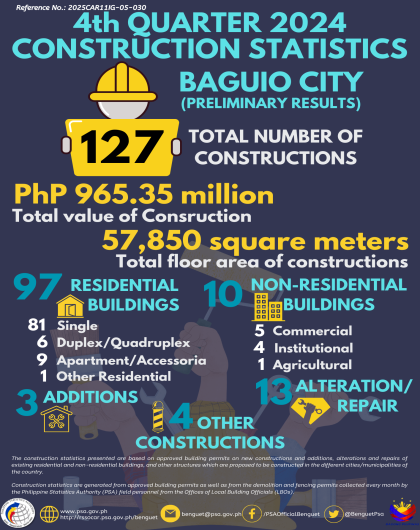CAR contributes 0.7 percent to the Philippine private construction
- The share of construction projects in the region to the total building construction in the country decreased by 20.0 percent during the second quarter of 2018 as compared to the region’s share of 0.9 percent during the same quarter of 2017.
-
A total of 281 new building constructions were recorded from the approved building permits in CAR for the second quarter of 2018. These had a total floor area of 108,960 square meters, and valued at PHP 1.1 billion. This reflects a decrease of 11.1 percent from 316 building projects in the same quarter in 2017.
3 in 4 buildings are residential buildings
- Residential building constructions comprised 74.7 percent of the region’s construction projects in the second quarter of 2018. These constructions comprised 210 houses, valued at PHP 625 million with a total floor area of 53,026 square meters. This was a decrease of 10.3 percent from the 234 projects reported in the same quarter in 2017.
-
Meanwhile, non-residential building constructions comprised 18.5 percent with a total floor area of 55,339 square meters and valued at PHP 448 million. This increased by 13.0 percent from 46 projects in the second quarter of 2017.
-
Additions to existing buildings comprised 1.4 percent of the private constructions. These declined by 55.6 percent from the same quarter in 2017, while alteration and repairs shared 5.3 percent of the constructions in the second quarter of 2018.
- All types of residential constructions were located in Benguet and Baguio areas with a total of 147 building projects recorded in the second quarter of 2018. A total of 136 units were designed for single occupancy, 1 unit for duplex/quadruplex, 8 new apartmenst/accesoria, and 2 residential condominiums.
-
Apayao recorded 52 building constructions in the second quarter of 2018. All were designed for single occupancy.
-
Four (4) units for single occupancy were built both in Ifugao and Kalinga, while three single occupancy units were built in Abra.
- Non-residential construction consist of commercial buildings, industrial buildings, institutional, agricultural, and other non-residential construction.
-
Apayao had almost triple-digit increase in the total number of non-residential constructions, from 7 constructions in the second quarter of 2017 to 19 constructions same quarter in 2018. These constructions were valued at PHP 12 million and had total floor area of 1,995 square meters.
-
Benguet posted a 22.0 percent decrease from its previous number of 23 constructions to 18 constructions. These constructions had a total floor area of 47,931 square meters and were valued at PHP 377 million.
-
Both Abra and Kalinga provinces had approved 5 non-residential buildings for construction during the second quarter of 2018 with a combined value of PHP 51 million and floor area of 4,822 square meters.
-
Ifugao and Mountain Province had the least number of approved non-residential constructions with 4 buildings and 1 building, respectively.
2 in 4 approved commercial buildings are stores
- Stores comprised 51.9 percent of the total commercial buildings under the nonresidential construction in the second quarter of 2018. These had a combined floor area of 4,854 square meters valued at PHP 51 million. Most of the stores were built in Apayao (8), followed by Benguet (3), Ifugao (2), and Abra (1).
-
Three new hotels were approved for construction with a total floor area of 6,513 square meters valued at PHP 50 million. These hotels were located in Benguet (2), and Abra (1).
-
There were 10 units of commercial buildings approved for construction with a total floor area of 14,393 square meters valued at PHP 99 million.
More schools are built in Apayao
- There were 13 new school building projects for the second quarter of 2018 in the region with a total area of 18,543 square meters amounting to PHP 106 million. Apayao had 8 new school buildings, Benguet with 3 new schools, and Kalinga with 2 new schools.
-
New churches and other religious structures were approved for construction in Benguet and Kalinga. These constructions had total floor area of 432 square meters valued at PHP 4.3 million.
-
The were also 5 other institutional building constructions located all over the provinces of CAR.
Additional industrial buildings in Benguet and Abra
- Additional industrial buildings were approved for construction with two constructions in Benguet and one construction in Abra. These constructions had a total floor area of 1,138 square meters amounting to PHP 8.2 million.
New agricultural buildings in Kalinga and Apayao
- Two barn/poultry houses were approved in Kalinga (1 building) and Apayao (1 building) valued at PHP 24.8 million with a total floor area of 2,520 square meters.
TECHNICAL NOTES


